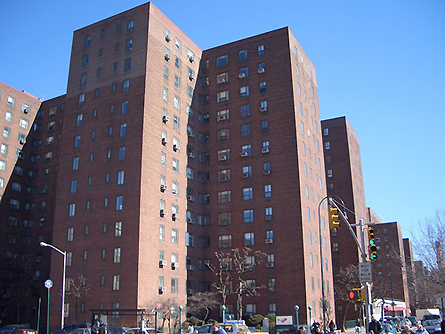
However else New Yorkers reacted to the sale last month of Stuyvesant Town and Peter Cooper Village, and to the announcement the same week that the Bloomberg administration would develop a new community on the “Queens West” site, it was inevitable that in the ensuing discussion some people would invoke the spirits of two larger-than-life figures in the history of New York City’s built environment – author and urban planning pioneer Jane Jacobs (who died on April 25th) and the city’s “master builder” Robert Moses (who died 25 years ago, in 1981).
This was inevitable because these two names are invoked nearly every week in debates about the future of New York City. Just the week before, in fact, the Gotham Center for New York City History presented a well-attended forum entitled “Jane Jacobs Vs. Robert Moses: How Stands the Debate Today?” which featured speakers ranging from the head of the New York City Planning Commission to the architecture critic of the New York Times.
But the Moses/Jacobs debate seems especially well-suited to Stuyvesant Town/Peter Cooper Village, since Moses actually played a substantial role in the building of these housing complexes, and Jacobs felt they were the antithesis of the “life on the street” that she adored in New York City. And across the East River in Long Island City, the 5,000 mixed-income housing units planned for the “Queens West” site would replace what would have been Olympic Village (had New York City been chosen to play host to the Olympics), reminiscent of Moses’ large-scale projects in Queens; his career was book-ended by the two World’s Fairs held in Flushing Meadows Park.
A closer look at both Stuyvesant Town and Queens West suggests the complications in using the usual arguments in the debate over Jane Jacobs and Robert Moses.
Has Jane Jacobs Won?
At the Gotham forum at CUNY Graduate Center, as throughout the city, Jacobs is generally praised and Moses is scorned. Neighborhood residents look at such projects as Atlantic Yards in Brooklyn, and see the kind of imperial efforts used by Robert Moses to roll over communities (as detailed in the biography of him by Robert Caro, The Power Broker). They cite Jacobs for her love of the “ballet of neighborhood life” and her opposition to planning from the top down, memorialized in her classic book, The Death and Life of Great American Cities.
“Jacobs has won the debate,” New York City Planning Commission Chair Amanda Burden declared at the forum, presenting the traditional view. (See her essay) The Department of City Planning, she said, now develops finely-grained, nuanced plans that seek to incorporate neighborhood feedback. Even when she plans for large-scale developments, she said, she imagines Jacobs looking over her shoulder.
But perhaps things are more complicated than they seem. Most of the presenters on the panel disputed the idea that “we are all Jacobs-ians now.” Richard Kahan (development czar under Mario Cuomo) agreed that "we are trying to have a diversity of uses where Moses was encouraging monolithic super blocks." But he argued that "we are still talking about mega projects, not bad, not good necessarily … but they are hardly paying much attention to neighborhood scale."
Other panelists presented revisionist views of the Jacobs vs. Moses debate. Columbia University professor Hilary Ballon argued that Moses got some important things right that Jacobs missed – especially a city’s need for large-scale infrastructure and large institutions such as universities. Ballon is curating a retrospective exhibition on Moses next year at the Queens Museum, the Museum of the City of New York, and Columbia. And two panelists (Samuel Zipp, a professor at the University of California-Irvine, and I) cited a paper by Damon Rich arguing that the image of “big plans and little people,” in which government planning is always seen to roll over neighborhood residents, has in many cases been used to give cover to conservative arguments that we ought to accept for our cities whatever the “free market” gives us.
Stuyvesant Town and Peter Cooper Village
At first, Stuyvesant Town/Peter Cooper Village might seem to follow the usual argument. The 11,500-unit development was created through eminent domain – pushed through by Moses – that displaced several thousand residents in a low-rise, tenement style, mixed-use neighborhood. It was planned from the top-down, built in “towers on the park” super-blocks, and has no street life. At the beginning, it was a segregated community; African-Americans were not allowed to live there.

And yet five decades later it is seen by most residents and planning observers as a supremely successful place. Community life thrives within its interiorized open spaces. And while it has not become the city’s most diverse community, it has become an enclave for the middle-class within a sea of far more expensive and socially homogeneous luxury housing.
From one angle, the recently-announced purchase of the property by Tishman Speyer from MetLife shows just how successful the property has become. The issue now, of course, is not about whether Stuyvesant Town is a planning affront, but how to save it as a middle class community. The purchase price of $5.4 billion can only be supported by substantial increases in the rents, by taking units out of rent regulation over time. The offering circular for the sale suggested that the complex could be converted from 75 percent rent regulated units now to only 30 percent rent regulated by 2018.
The same offering circular also proposed several ideas that might be seen as “bringing Jacobs back in” -- improving the retail mix along the streets, and perhaps the creation of new buildings that might better integrate with the grid -- as ways that potential buyers could bring in higher-paying tenants and increase the value of the property.
The threat to diversity in this case, then, comes not from top-down planning but from the marketplace. In fact, the only thing that has preserved a more diverse, more middle-income community at Stuyvesant Town is government action and regulation. The affordability requirements that came with the tax breaks MetLife received to build the property expired decades ago. Since then, it is only rent regulations that have kept the units affordable. And it is the weakening of those laws that has made the sale possible. In 1994, the New York State legislature began to allow “vacancy deregulation,” by which units can be taken out of the rent regulation system upon vacancy once their rents exceed $2,000 – and increasingly, landlords can deregulate units that rent for several hundred dollars less than this through major capital improvements.
Queens West
 The proposed development of Queens West is also more complicated than the traditional “Jacobs vs. Moses” debate frame would suggest. The development will likely be in high-rise towers with a master plan created by City Hall – the type that Jacobs would likely have scorned: In 2005, just a few months before her death, she wrote a scathing critique of the Bloomberg administration’s similar proposal for the Greenpoint-Williamsburg waterfront just to the south. Yet local residents, community board leaders, and elected officials all praised the proposed development of the site. The most popular element of the plan is that it would provide housing for the “middle class,” for households earning from $60,000 to $145,000 each year.
The proposed development of Queens West is also more complicated than the traditional “Jacobs vs. Moses” debate frame would suggest. The development will likely be in high-rise towers with a master plan created by City Hall – the type that Jacobs would likely have scorned: In 2005, just a few months before her death, she wrote a scathing critique of the Bloomberg administration’s similar proposal for the Greenpoint-Williamsburg waterfront just to the south. Yet local residents, community board leaders, and elected officials all praised the proposed development of the site. The most popular element of the plan is that it would provide housing for the “middle class,” for households earning from $60,000 to $145,000 each year.
It is important to note that the proposed development hardly serves the diversity of Queens. More than 60 percent of Queens residents earn less than $60,000 – so most of Queens two million people will not be able to afford even one of the proposed 5,000 “affordable” units. A diverse set of Queens community organizations, known as Queens for Affordable Housing, is calling for a far better mix, with half of the units affordable to families earning less than the Queens median income of $48,000.
Here, as in Stuyvesant Town and Peter Cooper Village, it appears that what communities fear is less mega-projects imposed by the government than market-led development that creates luxury housing that only the wealthiest New Yorkers can afford.
Neither Top-Down Nor Natural Evolution Of Markets
It is not simply income and racial diversity that is in question. New York City’s growth and consequent market-led real estate pressures are putting strains on the quality of life of neighborhoods in every corner or the city – more traffic, more people using scarce open space, overcrowded schools in many growing neighborhoods, tear-downs of historic structures.
The answers will not be found in Moses’ style top-down mega-projects, which led to massive increases in traffic and were in many instance contemptuous of the very poor families they were serving (although he did create more open space that anyone before or since).
But the answers also won’t be found – as some who invoke Jacobs’ name today try to do – in seeking to prevent development altogether, nor in diminishing the role of government in city-building. New York City is expected to grow by one million people (mostly as a result of immigration) in the coming decades. We need thoughtful city planning and smart, activist government to make that growth work for New York’s communities.
To keep the city diverse and affordable, we’ll need not only more investments in affordable housing, but also strengthened rent regulations to enable those who are here already to stay. To preserve mixed-use communities, we need stronger zoning provisions that allow manufacturers to survive in the city. To make the new jobs created by all this growth and development pay enough for a family to live in the city, we’ll need “living wage” regulations that make sure we aren’t using our tax dollars and public planning to subsidize poverty wages.
To address ever-increasing traffic – in a region that already has the longest commute times in the nation – we are going to need both “congestion pricing” (charging people something when they drive in Lower/Midtown Manhattan) and investments in more transit infrastructure. To truly improve quality of life and create more green space, we will need to de-map some of the area we now give to streets, to let pedestrians have more room in their neighborhoods.
Many of these issues will be at stake over the next few months as the Bloomberg administration begins to reveal more about the work of its newly created Office of Long-Term Planning and Sustainability (profiled in Gotham Gazette’s land use column).
As the new office begins its work, it might take heart in looking neither to Jacobs nor to Moses – but instead to two efforts in the Bronx. At the Kingsbridge Armory – after many years of organizing by the Northwest Bronx Community and Clergy Coalition – the New York City Department of Economic Development recently sought proposals for a 575,000 square foot redevelopment to include a mix of retail, entertainment, recreational, and community uses. Several schools will be developed in an adjacent campus. For the first time, City Hall agreed to favor developers who commit to pay a living wage to workers. Unlike the displacement of the Bronx Terminal Market last year for a large-scale retail mall, when many community groups and small business advocates criticized the administration, in this case there was praise from all side.
Two miles to the southeast, residents of Soundview, Hunts Point, and West Farms are open to an even larger development. The Southern Bronx River Watershed Alliance – a coalition of four community organizations and three citywide groups – have proposed the demolition of the Sheridan Expressway, an unnecessary blight on the neighborhood built, of course, by Robert Moses. This summer, through a series of community planning sessions, they developed a plan for something far grander in its place: a mixed-use, mixed-income development that would include thousands of units of housing; new commercial, retail, and community facilities; and new open spaces.
The (hopeful) lesson: we don’t have to choose between top-down Moses mega-projects (that accommodate growth but undermine communities) and the natural evolution of markets in places like Jacobs’ West Village that may preserve neighborhood character but results in a neighborhood that very few can afford. When people are truly included in the planning, when development comes with real and more fairly-shared benefits, and when smart public policy helps shape growth to make it work for neighborhoods, communities can be willing to accept large-scale development and shoulder their share of the city’s growth.
Brad Lander is the director of the Pratt Center for Community Development.
Â




